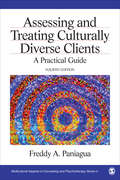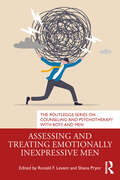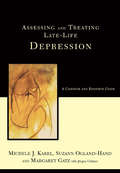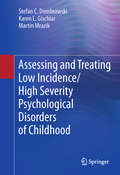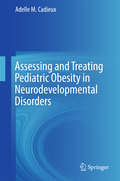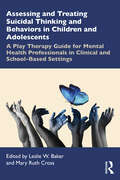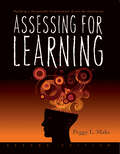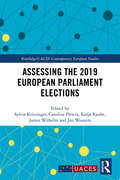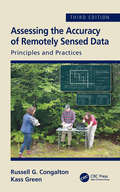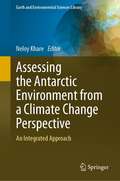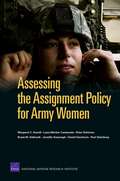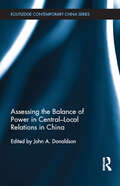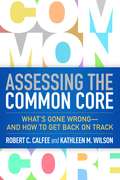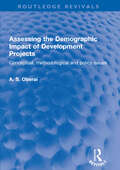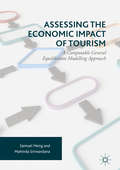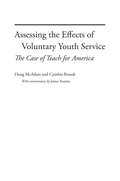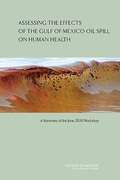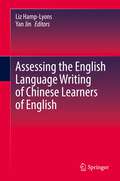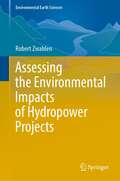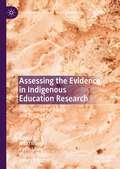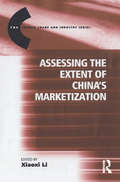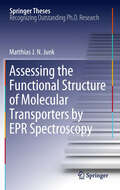- Table View
- List View
Assessing and Treating Culturally Diverse Clients: A Practical Guide
by Freddy A. PaniaguaNow in its Fourth Edition, the best-selling Assessing and Treating Culturally Diverse Clients offers effective, practical guidelines in working with culturally diverse clients. Author and clinician Freddy A. Paniagua first summarizes general guidelines that clinicians can apply when assessing, diagnosing, or treating culturally diverse clients, but also addresses clinical work with specific culturally diverse groups such as African American, Hispanic, American Indian, and Asian clients. Two new chapters in this edition deal with the assessment, diagnoses, and treatment of emotional problems experienced by LGBT and older adult clientsfrom these culturally diverse groups.
Assessing and Treating Emotionally Inexpressive Men (The Routledge Series on Counseling and Psychotherapy with Boys and Men)
by Ronald F. Levant and Shana PryorWhat if your new client, a man in his early 40s, cannot answer basic questions in your initial assessment interview? You were aware that many men do not like to talk about their feelings, but this client seems kind of frozen. You think he might be alexithymic, but you do not know how to assess for that, or even more importantly, how to treat it. Assessing and Treating Emotionally Inexpressive Men has answers. Chapters explain why some men are emotionally inexpressive because of their childhood socialization, and the book provides both scales for assessing alexithymia in men and treatment manuals for helping these men became more emotionally self-aware in individual and group therapy. The book also offers case studies that explains how to integrate the authors’ approach with any model of psychotherapy. Clinicians will come away from this book with a clear sense for how to treat alexithymia in the early sessions of psychotherapy and thereby improve treatment uptake and outcomes.
Assessing and Treating Late-Life Depression: A Casebook and Resource Guide
by Michele J. Karel Suzann Ogland-Hand Margaret Gatz Jürgen UnützerNot only is depression among the elderly treatable but, given its increase in incidence and a rapidly aging population, it is a critical issue for the mental-health and medical communities. The authors review the range of late-life depressive syndromes and the strategies for assessing and treating them, and illustrate the problems and principles with fourteen extended case studies-rare in the geropsychology literature and the core of the book. They also provide a guide to medications, screening tools, innovative models, and supplementary resources, invaluable tools for mental-health professionals and medical practitioners alike.
Assessing and Treating Low Incidence/High Severity Psychological Disorders of Childhood
by Stefan C. Dombrowski Martin Mrazik Karen L. GischlarDuring the past several decades, interest in children's psychological disorders has grown steadily within the research community, resulting in a burgeoning knowledge base. The majority of the attention and funding, not surprisingly, has focused on the more prevalent and well-known conditions. Although this raises the odds that young people with more well-known disorders such as ADHD, autism, and learning disorders will receive much-needed professional assessment and intervention, children with less frequently encountered disorders may experience a higher risk of misdiagnosis and inappropriate treatment. Useful data has been scattered throughout the literature for severe-but-less-frequent childhood psychological disorders, including: fire setting; gender identity disorder; impulse control disorders (i.e., kleptomania, trichotillomania, intermittent explosive disorder); selective mutism; Munchausen by proxy; childhood schizophrenia; gang involvement; sexual offending; self-injurious behavior; and feral children. This concise volume offers up-to-date information on these conditions, which, though relatively rare, may have profound effect not only on the children themselves but also their families, friends, and the community at large. Coverage of each disorder is presented in an accessible format covering: Overview and history.Description and diagnostic classification, with proposed changes to the DSM-V.Etiology and theory.Assessment tools and interview protocols.Commonly used psychological and pharmacological treatment options.Current research issues and directions for future investigation. Assessing and Treating Low Incidence/High Severity Psychological Disorders of Childhood is a must-have reference for researchers, clinicians, practitioners, and graduate students in clinical child and school psychology, pediatrics, psychiatry, social work, school counseling, education, and public policy.
Assessing and Treating Pediatric Obesity in Neurodevelopmental Disorders
by Adelle M. CadieuxThis book reviews strategies for assessing and treating pediatric obesity in children with neurodevelopmental disorders (ND). It synthesizes empirical findings and clinical strategies to offer the latest knowledge in key areas, including risk factors, physical activity, nutrition, treatment planning, goal-setting, and engagement with patients. A four-stage treatment model presents clinical guidance in triaging treatment and tailoring interventions to children's changing medical, behavioral, emotional, and cognitive needs. The book complements current pediatric ND literature by presenting clear guidelines for integrating treatment for obesity into existing treatment of these young patients. Topics featured in this book include: The effect of neurodevelopmental disorders on the assessment of obesity in children. The impact of developmental delays on physical activities and health behaviors. Strategies for promoting weight management goals in pediatric ND. Suggestions on how to engage and support families and caregivers. The role of prevention in weight management within pediatric ND. Assessing and Treating Pediatric Obesity in Neurodevelopmental Disorders is a must-have resource for clinicians, scientist-practitioners, and related professionals as well as researchers, professors, and graduate students in clinical child and school psychology, public health, social work, pediatrics, occupational therapy, and nutrition.
Assessing and Treating Suicidal Thinking and Behaviors in Children and Adolescents: A Play Therapy Guide for Mental Health Professionals in Clinical and School-Based Settings
by Leslie W. Baker Mary Ruth CrossAssessing and Treating Suicidal Thinking and Behaviors in Children and Adolescents is a guide to working with children and young people who present with either obvious or hidden suicidal thoughts, preoccupations, or plans.Chapters explore a range of treatment approaches and focus on how to support parents, caregivers, families, and schools. Expressive therapies are highlighted, but the chapters also cover evidence-based models such as cognitive-behavioral therapy (CBT), dialectical behaviour therapy (DBT), and prescriptive play therapy. Expressive therapists, school-based counselors, and other clinicians who work with at-risk children and adolescents from diverse communities and backgrounds will come away from this book with the tools they need to integrate the individual child’s capabilities, sources of distress, and internal and external resources in order to build a developmentally sensitive treatment plan.
Assessing for Learning: Building a Sustainable Commitment Across the Institution
by Peggy L. MakiWhile there is consensus that institutions need to represent their educational effectiveness through documentation of student learning, the higher education community is divided between those who support national standardized tests to compare institutions’ educational effectiveness, and those who believe that valid assessment of student achievement is based on assessing the work that students produce along and at the end of their educational journeys. This book espouses the latter philosophy—what Peggy Maki sees as an integrated and authentic approach to providing evidence of student learning based on the work that students produce along the chronology of their learning. She believes that assessment needs to be humanized, as opposed to standardized, to take into account the demographics of institutions, as students do not all start at the same place in their learning. Students also need the tools to assess their own progress. In addition to updating and expanding the contents of her first edition to reflect changes in assessment practices and developments over the last seven years, such as the development of technology-enabled assessment methods and the national need for institutions to demonstrate that they are using results to improve student learning, Maki focuses on ways to deepen program and institution-level assessment within the context of collective inquiry about student learning. Recognizing that assessment is not initially a linear start-up process or even necessarily sequential, and recognizing that institutions develop processes appropriate for their mission and culture, this book does not take a prescriptive or formulaic approach to building this commitment. What it does present is a framework, with examples of processes and strategies, to assist faculty, staff, administrators, and campus leaders to develop a sustainable and shared core institutional process that deepens inquiry into what and how students learn to identify and improve patterns of weakness that inhibit learning. This book is designed to assist colleges and universities build a sustainable commitment to assessing student learning at both the institution and program levels. It provides the tools for collective inquiry among faculty, staff, administrators and students to develop evidence of students’ abilities to integrate, apply and transfer learning, as well as to construct their own meaning. Each chapter also concludes with (1) an Additional Resources section that includes references to meta-sites with further resources, so users can pursue particular issues in greater depth and detail and (2) worksheets, guides, and exercises designed to build collaborative ownership of assessment.The second edition now covers: * Strategies to connect students to an institution’s or a program’s assessment commitment* Description of the components of a comprehensive institutional commitment that engages the institution, educators, and students--all as learners* Expanded coverage of direct and indirect assessment methods, including technology-enabled methods that engage students in the process* New case studies and campus examples covering undergraduate, graduate education, and the co-curriculum* New chapter with case studies that presents a framework for a backward designed problem-based assessment process, anchored in answering open-ended research or study questions that lead to improving pedagogy and educational practices* Integration of developments across professional, scholarly, and accrediting bodies, and disciplinary organizations* Descriptions and illustrations of assessment management systems* Additional examples, exercises, guides and worksheets that align with new content
Assessing the 2019 European Parliament Elections (Routledge/UACES Contemporary European Studies #1)
by Jan Wouters Sylvia Kritzinger Carolina Plescia Kolja Raube James WilhelmInformed by and against the backdrop of the 2019 European Parliament (EP) elections, this innovative book provides a critical assessment of where Europe stands in terms of the quest to achieve democratic legitimacy. Since the 2014 EP elections, the European Union (EU) has experienced multiple crises, which arguably have undermined its legitimacy. The 2019 EP elections were hence seen as a crucial moment in the EU’s attempts to show resilience and regain trust. Using political science and legal frames of analysis, Assessing the 2019 European Parliament Elections provides an understanding and assessment of the current politico-legal framework, and its impact on European elections. Furthermore, using original data, it provides a timely examination of public opinion issue priorities and voting behaviour at the 2019 EP elections in eight countries. Given the critical conjuncture that the 2019 EP elections represent, this volume provides a key contribution to understanding both the dynamics surrounding the elections, as well as voters’ responses, and informs debates on European politics, for example, second-order elections, democratic legitimacy and political representation. This book will be of key interest to scholars and students of EU politics, public administration, European studies, European law, and sociology, along with practitioners in politics, journalism, and policy analysis.
Assessing the 2020 Census: Final Report
by Committee on National Statistics Division of Behavioral and Social Sciences and Education National Academies of Sciences, Engineering, and Medicine Panel to Evaluate the Quality of the 2020 CensusSince 1790, the U.S. census has been a recurring, essential civic ceremony in which everyone counts; it reaffirms a commitment to equality among all, as political representation is explicitly tied to population counts. Assessing the 2020 Census looks at the quality of the 2020 Census and its constituent operations, drawing appropriate comparisons with prior censuses. The report acknowledges the extraordinary challenges the Census Bureau faced in conducting the census and provides guidance as it plans for the 2030 Census. In addition, the report encourages research and development as the goals and designs for the 2030 Census are developed, urging the Census Bureau to establish a true partnership with census data users and government partners at the state, local, tribal, and federal levels.
Assessing the Accuracy of Remotely Sensed Data: Principles and Practices, Third Edition (Mapping Science Ser.)
by Russell G. Congalton Kass GreenThe past 10 years have brought amazing changes to the technologies used to turn remotely sensed data into maps. As a result, the principles and practices necessary for assessing the accuracy of those maps have also evolved and matured. This third edition of Assessing the Accuracy of Remotely Sensed Data: Principles and Practices is thoroughly updated and includes five new chapters. Now 15 chapters long, this text is the only one of its kind to provide geospatial analysts with the requisite considerations, tools, and theory necessary to conduct successful and efficient map accuracy assessments; and map users with the knowledge to fully understand the assessment process to ensure effective use of maps. See What’s New in the Third Edition: All original chapters have been updated to include new standards, practices, and methodologies. A new chapter on planning accuracy assessments. A new chapter on assessing maps created using object-based technologies. Two case study chapters - one showcasing the assessment of maps created from traditional methods, and one on the assessment of object-based maps. Emphasis on considering and planning for positional accuracy in concert with thematic accuracy. An appendix containing the internationally recognized ASPRS Positional Accuracy Standards. A new final chapter summarizing the key concepts, considerations and lessons learned by the authors in their decades of implementing and evaluating accuracy assessments. Assessing map accuracy is complex; however, the discussions in this book, together with the many figures, tables, and case studies, clearly present the necessary concepts and considerations for conducting an assessment that is both is practical, statistically reliable, and achievable.
Assessing the Antarctic Environment from a Climate Change Perspective: An Integrated Approach (Earth and Environmental Sciences Library)
by Neloy KhareThe present book covers diversified contributions addressing the impact of climate change on the Antarctic environment. It covers the reconstruction of environmental changes using different proxies. The chapters focus on the glacial history, glacial geomorphology, sedimentology, and geochemistry of Antarctic region. Furthermore, the Cenozoic evolution of the Antarctic ice sheet is discussed along with a Scientometrics analysis of climate change research. The book serves as a useful reference for researchers who are fascinated by the polar region and environmental research.
Assessing the Assessment: A Critical Look at the June 2003 Assessment of the United Kingdom's Five Tests for Euro Entry
by Carlo Cottarelli Julio EscolanoA report from the International Monetary Fund.
Assessing the Assignment Policy for Army Women
by Margaret C. Harrell Jennifer Erin Kavanagh Bryan W. Hallmark Peter Schirmer Laura WerberSince current policies for assigning military women were issued, the U.S. Army has changed how it organizes and fights. Assessing the Assignment Policy for Army Women considers whether the Army is adhering to the assignment policies as well as the appropriateness of the current U.S. Department of Defense and Army assignment policies, given how units are operating in Iraq.
Assessing the Balance of Power in Central-Local Relations in China (Routledge Contemporary China Series)
by John DonaldsonHow do we understand the evolution of central-local relations in China during the reform period? This book addresses this question by focusing on eight separate issues in which the central-local relationship has been especially salient – government finance, investment control, regional development, administrative zoning, implementation, culture, social welfare and international relations. Each chapter introduces a sector and the way the center and various local governments have shared or divided power over the different periods of China’s reform era. The balance of power is gauged dynamically over time to measure the extent to which one level of government dominates, influences or shares power in making decisions in each of these particular domains, as well as what is likely to occur in the foreseeable future. The authors assess the winners and losers of these changes among key actors in China’s society. The result provides a dynamic view of China’s changing power relations.
Assessing the Common Core
by Robert C. Calfee Kathleen M. WilsonFrom distinguished educators, this book imagines what our schools could look like if an authentic vision of the Common Core State Standards (CCSS) were put in place, and thoughtfully critiques how and why implementation has faltered. The authors outline a curriculum framework that focuses on student-based inquiry and the use of formative assessment to monitor and guide student learning. They provide workable, innovative alternatives to the packaged instructional programs and summative tests that have come to be associated with the English language arts (ELA) standards. Vignettes of diverse schools and districts highlight a range of successful approaches to making the CCSS work.
Assessing the Demographic Impact of Development Projects: Conceptual, methodological and policy issues (Routledge Revivals)
by A. S. OberaiFirst published in 1992, Assessing the Demographic Impact of Development Projects based on studies in developing countries focuses on conceptual, methodological and policy issues related to development projects. It considers whether demographic effects can be assessed and why development planners should be interested in such an assessment. A.S. Oberai examines the extent to which economic and social changes generated by specific development interventions have influenced demographic behaviour in a particular context. He suggests how desired effects can be enhanced and undesired effects minimized by policy makers and planners in developing countries in order to deal with problems of population growth and its distribution. The major shortcomings of existing methodologies are identified, and the author indicates the future direction which research might take in order to be more scientifically valid and useful to policy makers. This book is a must read for scholars and researchers of development studies, political economy and labour economy.
Assessing the Economic Impact of Tourism: A Computable General Equilibrium Modelling Approach
by Samuel Meng Mahinda SiriwardanaThis book employs a computable general equilibrium (CGE) model - a widely used economic model which uses actual data to provide economic analysis and policy assessment - and applies it to economic data on Singapore's tourism industry. The authors set out to demonstrate how a novice modeller can acquire the necessary skills and knowledge to successfully apply general equilibrium models to tourism studies. The chapters explain how to build a computable general equilibrium model for tourism, how to conduct simulation and, most importantly, how to analyse modelling results. This applied study acts as a modelling book at both introductory and intermediate levels, specifically targeting students and researchers who are interested in and wish to learn computable general equilibrium modelling. The authors offer insightful analysis of Singapore's tourism industry and provide both students and researchers with a guide on how to apply general equilibrium models to actual economic data and draw accurate conclusions.
Assessing the Effects of Voluntary Youth Service
by James YounissThis book uses survey data from all accepted applicants to Teach for America 1993-98 to assess the longer-term effect of youth service on participants' current civic attitudes and behaviors. While TFA "graduates" score higher than the two comparison groups – "dropouts" and "non-matriculants" – on a broad range of attitudinal items measuring civic commitment, these differences appear to be less a byproduct of the TFA experience than a reflection of current involvement with the TFA organization. Moreover, the attitudinal differences are not reflected in actual civic behavior. Specifically, graduates lag behind non-matriculants in current service activity and generally trail both non-matriculants and drop-outs in self-reported participation in five other forms of civic/political activity measured in the study. Graduates also vote at lower rates than the other two groups. Finally, fewer graduates report employment in "pro-social" jobs than either non-matriculants or drop-outs. The authors close by speculating on what mechanisms may help explain variation in the long-term effects of youth service or activist experiences.
Assessing the Effects of the Gulf of Mexico Oil Spill on Human Health: A Summary of the June 2010 Workshop
by Institute of Medicine of the National AcademiesFrom the origin of the leak, to the amount of oil released into the environment, to the spill's duration, the 2010 Gulf of Mexico oil spill poses unique challenges to human health. The risks associated with extensive, prolonged use of dispersants, with oil fumes, and with particulate matter from controlled burns are also uncertain. There have been concerns about the extent to which hazards, such as physical and chemical exposures and social and economic disruptions, will impact the overall health of people who live and work near the area of the oil spill. Although studies of previous oil spills provide some basis for identifying and mitigating the human health effects of these exposures, the existing data are insufficient to fully understand and predict the overall impact of hazards from the Deepwater Horizon oil spill on the health of workers, volunteers, residents, visitors, and special populations. Assessing the Effects of the Gulf of Mexico Oil Spill on Human Healthidentifies populations at increased risks for adverse health effects and explores effective communication strategies to convey health information to these at-risk populations. The book also discusses the need for appropriate surveillance systems to monitor the spill's potential short- and long-term health effects on affected communities and individuals. Assessing the Effects of the Gulf of Mexico Oil Spill on Human Healthis a useful resource that can help policy makers, public health officials, academics, community advocates, scientists, and members of the public collaborate to create a monitoring and surveillance system that results in "actionable" information and that identifies emerging health risks in specific populations.
Assessing the English Language Writing of Chinese Learners of English
by Yan Jin Liz Hamp-LyonsThis book focuses on the assessment of English language writing in China mainland, the territories of Hong Kong and Macau, and Taiwan. The first part of the book describes how writing in English has been assessed in Chinese contexts in the past 25 years, and how it continues to be assessed at present. The second part of the book presents reports of work such as formative classroom-based assessment, feedback-based or feedback-led approaches, learning-oriented assessment, portfolios, as well as the important issue of teacher professional development in writing assessment. This two-part division relates to and reflects what has been happening in writing assessment internationally, in the UK from the 1940s, and in the US in the past 25 years.The use of English for international business communication, for international political negotiations and its rapidly increasing use as a medium of instruction in some subject areas has led to a rapid increase in the numbers of Chinese L1 speakers who are learning and being assessed in English. This is often done with an emphasis on reading and writing. The vast majority of assessments of English language writing are done through large-scale direct testing that uses simple prompts/tasks and short writing samples. This book explores best practices in assessing the writing in English of native speakers of Chinese.Assessing the English Language Writing of Chinese Learners of English edited by long-time experts Liz Hamp-Lyons and Yan Jin clearly demonstrates the authors’ collective years of writing and teaching about writing assessment. The book’s 13 chapters, written by recognized experts in assessment of Chinese speakers learning English, represent a wide array of important topics written in reader friendly language and offering evidence for pedagogical practices as well as high-stakes testing of writing. Teachers, researchers, administrators of writing programs in China, and test developers who seek counsel about this population need look no further than to add Assessing the English Language Writing of Chinese Learners of English to their reading list. Deborah Crusan, Wright State University, USA
Assessing the Environmental Impacts of Hydropower Projects (Environmental Earth Sciences)
by Robert ZwahlenThis book describes the entire process of environmental impact assessment for hydropower and dam projects, not from a legal or regulatory point of view, but from a very applied one, based mainly on the personal experience of the author, who is involved in this field of work since over 40 years, by describing the different steps of such an assessment, covering all major aspects to be dealt with. The focus is on environmental issues, while the other main subject—social impacts—is mentioned here only briefly. It will be of interest not only for ESIA (Environmental and Social Impact Assessment) practitioners, be they consultants involved in the preparation of such studies or staff members of environmental protection agencies having to come to decisions based on them, but also for engineers and planners involved in such projects, developers, and people interested in questions related to energy, environment, and climate change. Overall, this book aims at contributing to put the discussion about hydropower and dam projects on a more objective level.
Assessing the Evidence in Indigenous Education Research: Implications for Policy and Practice (Postcolonial Studies in Education)
by Kevin Lowe Karen Trimmer Roselyn Dixon Nikki MoodieThis book explores the current state of research on Indigenous education Australia. In particular, these chapters focus on exploring deep and enduring questions about the failures of schooling to address the needs of Aboriginal communities. This book provides a systematic analysis of existing research to explain how connection to culture - and the recognition of Indigenous sovereignties and knowledges - are the keys to Aboriginal excellence in schooling.
Assessing the Extent of China's Marketization (The Chinese Trade and Industry Series)
by Xiaoxi LiChina is indisputably one of the most dynamic economic regions in the world; however the character, nature and extent of its market economy status remains in question. This book provides an empirical analysis of many aspects of the developing market economy including: government reform; the marketization of enterprises; land transactions; capital transactions and finance; the market determination of wage rates; the development of intermediary organizations; and the improvement in the economy's legal framework. China's economic growth has also brought conflict with both the EU and the US. This book examines the contentious debates such as: the extent of renminbi convertibility; the independence of the financial sector; the freedom of labour in wage-rate bargaining; the extent of foreign investment; the extent of government ownership of enterprises; the protection of property rights; and the development of company law and of corporate governance.
Assessing the Feasibility of the Strategic Long Range Cannon: Unclassified Summary
by Division on Engineering and Physical Sciences National Academies of Sciences, Engineering, and Medicine Board on Army Research and Development Committee on Assessing the Feasibility of the Strategic Long Range CannonThe U.S. Army is working on a major science and technology development program to build the Strategic Long Range Cannon to fire a hypersonic projectile 1,000 miles. At the request of the Deputy Assistant Secretary of the Army for Research and Technology, the Committee on Assessing the Feasibility of the Strategic Long Range Cannon made recommendations for the U.S. Army in the following categories: organizational, operational, and technical demonstration development areas. This publication is the unclassified summary of the full, classified report.
Assessing the Functional Structure of Molecular Transporters by EPR Spectroscopy (Springer Theses)
by Matthias J.N.JunkIn his thesis, Matthias Junk takes an innovative approach to assess the local structure and dynamics of biological and synthetic amphiphilic macromolecules capable of transporting small molecules. Replacing the latter with stable radicals, he uses state-of-the-art electron paramagnetic resonance (EPR) spectroscopy to describe the highly relevant transport function from the viewpoint of the guest molecules. Such, he demonstrates that the functional structure of human serum albumin in solution significantly differs from its crystal structure - a consequence of the protein's adaptability to host various endogenous compounds and drug molecules. Further, he shows that the thermal collapse of thermoresponsive hydrogels and dendronized polymers leads to static and dynamic heterogeneities on the nanoscale. These heterogeneities bear consequences for the material's hosting properties and enable unforeseen complex catalytic functionalities.
